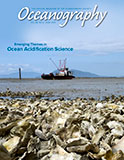Article Abstract
Numerous monitoring efforts are underway to improve understanding of ocean acidification and its impacts on coastal environments, but there is a need to develop a coordinated approach that facilitates spatial and temporal comparisons of drivers and responses on a regional scale. Toward that goal, the California Current Acidification Network (C-CAN) held a series of workshops to develop a set of core principles for facilitating integration of ocean acidification monitoring efforts on the US West Coast. The recommended core principles include: (1) monitoring measurements should facilitate determination of aragonite saturation state (Ωarag) as the common currency of comparison, allowing a complete description of the inorganic carbon system; (2) maximum uncertainty of ±0.2 in the calculation of Ωarag is required to adequately link changes in ocean chemistry to changes in ecosystem function; (3) inclusion of a variety of monitoring platforms and levels of effort in the network will insure collection of high-frequency temporal data at fixed locations as well as spatial mapping across locations; (4) physical and chemical oceanographic monitoring should be linked with biological monitoring; and (5) the monitoring network should share data and make it accessible to a broad audience.

